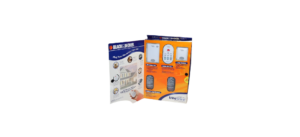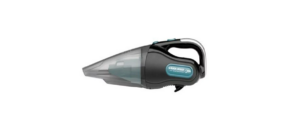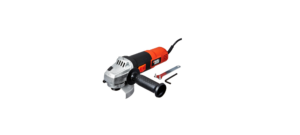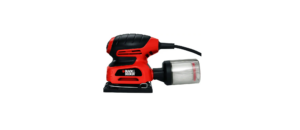Black & Decker BDCD8 Small Angle Grinder
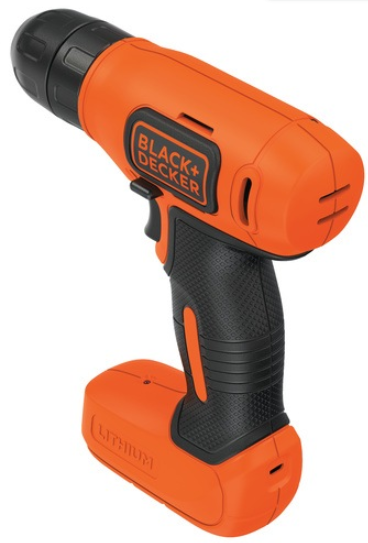
Introduction
A small and multipurpose tool for cutting, grinding, and polishing jobs is the Black & Decker BDCD8 Small Angle Grinder. This angle grinder’s ergonomic handle, lightweight design, and 820-watt motor make it perfect for both experts and do-it-yourselfers. It has an adjustable safety guard for user protection and a spindle lock for simple disc swaps. Whether you’re working with brick, stone, or metal, the BDCD8 offers accurate and dependable performance.
Intended use
Your BLACK+DECKER BDCD8 – Drill, has been designed for screwdriving applications and for drilling in wood, metal and plastic. This tool is intended for consumer use only.
Safety instructions
General power tool safety warnings
Failure to follow the warnings and instructions listed below may result in electric shock, fire and/or serious injury. Save all warnings and instructions for future reference. The term “power tool” in all of the warnings listed below refers to your mains operated (corded) power tool or battery operated (cordless) power tool.
Work area safety
- Keep work area clean and well lit. Cluttered or dark areas invite accidents.
- Do not operate power tools in explosive atmospheres, such as in the presence of flammable liquids, gases or dust. Power tools create sparks which may ignite the dust or fumes.
- Keep children and bystanders away while operating a power tool. Distractions can cause you to lose control.
Electrical safety
- Power tool plugs must match the outlet. Never modify the plug in any way. Do not use any adapter plugs with earthed (grounded) power tools. Unmodified plugs and matching outlets will reduce risk of electric shock.
- Avoid body contact with earthed or grounded surfaces such as pipes, radiators, ranges and refrigerators. There is an increased risk of electric shock if your body is earthed or grounded.
- Do not expose power tools to rain or wet conditions. Water entering a power tool will increase the risk of electric shock.
- Do not abuse the cord. Never use the cord for carrying, pulling or unplugging the power tool. Keep cord away from heat, oil, sharp edges or moving parts. Damaged or entangled cords increase the risk of electric shock.
- When operating a power tool outdoors, use an extension cord suitable for outdoor use. Use of a cord suitable for outdoor use reduces the risk of electric shock.
- If operating a power tool in a damp location is unavoidable, use a residual current device (RCD) protected supply. Use of an RCD reduces the risk of electric shock.
Personal safety
- Stay alert, watch what you are doing and use common sense when operating a power tool. Do not use a power tool while you are tired or under the influence of drugs, alcohol or medication. A moment of inattention while operating power tools may result in serious personal injury.
- Use personal protective equipment. Always wear eye protection. Protective equipment such as dust mask, non-skid safety shoes, hard hat, or hearing protection used for appropriate conditions will reduce personal injuries.
- Prevent unintentional starting. Ensure the switch is in the off-position before connecting to power source and/or battery pack, picking up or carrying the tool. Carrying power tools with your finger on the switch or energising power tools that have the switch on invites accidents.
- Remove any adjusting key or wrench before turning the power tool on. A wrench or a key left attached to a rotating part of the power tool may result in personal injury.
- Do not overreach. Keep proper footing and balance at all times. This enables better control of the power tool in unexpected situations.
- Dress properly. Do not wear loose clothing or jewellery. Keep your hair, clothing and gloves away from moving parts. Loose clothes, jewellery or long hair can be caught in moving parts.
- If devices are provided for the connection of dust extraction and collection facilities, ensure these are connected and properly used. Use of dust collection can reduce dust-related hazards.
- Do not let familiarity gained from frequent use of tools allow you to become complacent and ignore tool safety principles. A careless action can cause severe injury within a fraction of a second.
Power tool use and care
- Do not force the power tool. Use the correct power tool for your application. The correct power tool will do the job better and safer at the rate for which it was designed.
- Do not use the power tool if the switch does not turn it on and off. Any power tool that cannot be controlled with the switch is dangerous and must be repaired.
- Disconnect the plug from the power source and/or the battery pack from the power tool before making any adjustments, changing accessories, or storing power tools. Such preventive safety measures reduce the risk of starting the power tool accidentally.
- Store idle power tools out of the reach of children and do not allow persons unfamiliar with the power tool or these instructions to operate the power tool. Power tools are dangerous in the hands of untrained users.
- Maintain power tools. Check for misalignment or binding of moving parts, breakage of parts and any other condition that may affect the power tools operation. If damaged, have the power tool repaired before use. Many accidents are caused by poorly maintained power tools.
- Keep cutting tools sharp and clean. Properly maintained cutting tools with sharp cutting edges are less likely to bind and are easier to control.
- Use the power tool, accessories and tool bits etc. in accordance with these instructions, taking into account the working conditions and the work to be performed. Use of the power tool for operations different from those intended could result in a hazardous situation.
- Keep handles and grasping surfaces dry, clean and free from oil and grease. Slippery handles and grasping surfaces do not allow for safe handling and control of the tool in unexpected situations.
Battery tool use and care
- Recharge only with the charger specified by the manufacturer. A charger that is suitable for one type of battery pack may create a risk of fire when used with another battery pack.
- Use power tools only with specifically designated battery packs. Use of any other battery packs may create a risk of injury and fire.
- When battery pack is not in use, keep it away from other metal objects, like paper clips, coins, keys, nails, screws, or other small metal objects, that can make a connection from one terminal to another. Shorting the battery terminals together may cause burns or a fire.
- Under abusive conditions, liquid may be ejected from the battery; avoid contact. If contact accidentally occurs, flush with water. If liquid contacts eyes, additionally seek medical help. Liquid ejected from the battery may cause irritation or burns.
- Do not use a battery pack or tool that is damaged or modified. Damaged or modified batteries may exhibit unpredictable behaviour resulting in fire, explosion or risk of injury.
- Do not expose a battery pack or tool to fire or excessive temperature. Exposure to fire or temperature above 130 °C may cause explosion.
- Follow all charging instructions and do not charge the battery pack or tool outside the temperature range specified in the instructions.
- Charging improperly or at temperatures outside the specified range may damage the battery and increase the risk of fire.
Service
- Have your power tool serviced by a qualified repair person using only identical replacement parts. This will ensure that the safety of the power tool is maintained.
- Never service damaged battery packs. Service of battery packs should only be performed by the manufacturer or authorized service providers.
Safety Instructions for All Operations
- Wear ear protectors when impact drilling. Exposure to noise can cause hearing loss.
- Hold power tool by insulated gripping surfaces, when performing an operation where the cutting accessory or the fastener may contact hidden wiring.
- Cutting accessory or the fastener contacting a “live” wire may make exposed metal parts of the power tool “live” and could give the operator an electric shock.
- Brace the tool properly before use. This tool produces a high output torque and without properly bracing the tool during operation, loss of control may occur resulting in personal injury.
Safety Instructions When Using Long Drill Bits
- Never operate at higher speed than the maximum speed rating of the drill bit.
- At higher speeds, the bit is likely to bend if allowed to rotate freely without contacting the workpiece, resulting in personal injury.
- Always start drilling at low speed and with the bit tip in contact with the workpiece.
- At higher speeds, the bit is likely to bend if allowed to rotate freely without contacting the workpiece, resulting in personal injury.
- Apply pressure only in direct line with the bit and do not apply excessive pressure. Bits can bend causing breakage or loss of control, resulting in personal injury.
Additional safety instructions
Drill/ Driver
- Use clamps or other practical way to secure and support the workpiece to a stable platform. Holding the work by hand or against your body is unstable and may lead to loss of control.
- Accessories and tool may get hot during operation. Wear gloves when handling them if performing heat producing applications such as drilling metals.
- Air vents often cover moving parts and should be avoided. Loose clothes, jewelry or long hair can be caught in moving parts.
- Do not operate this tool for long periods of time. Vibration caused by tool action may be harmful to your hands and arms. Use gloves to provide extra cushion and limit exposure by taking frequent rest periods.
Safety of others
- This appliance can be used by children aged from 8 years and above and persons with reduced physical, sensory or mental capabilities or lack of experience and knowledge if they have been given supervision or instruction concerning use of the appliance in a safe way and understand the hazards involved.
- Children shall not play with the appliance. Cleaning and user maintenance shall not be made by children without supervision.
Residual risks
- Additional residual risks may arise when using the tool which may not be included in the enclosed safety warnings.
- These risks can arise from misuse, prolonged use etc.
- Even with the application of the relevant safety regulations and the implementation of safety devices, certain residual risks can not be avoided.
- Injuries caused by touching any rotating/moving parts.
- Injuries caused when changing any parts, blades or accessories.
- Injuries caused by prolonged use of a tool. When using any tool for prolonged periods ensure you take regular breaks.
- Impairment of hearing.
- Health hazards caused by breathing dust developed when using your tool (example:- working with wood, especially oak, beech and MDF.)
Vibration
- The declared vibration emission values stated in the technical data and the declaration of conformity have been measured in accordance with a standard test method provided by EN62841 and may be used for comparing one tool with another.
- The declared vibration emission value may also be used in a preliminary assessment of exposure.
- The vibration emission value during actual use of the power tool can differ from the declared value depending on the ways in which the tool is used.
- The vibration level may increase above the level stated.
When assessing vibration exposure to determine safety measures required by 2002/44/EC to protect persons regularly using power tools in employment, an estimation of vibration exposure should consider, the actual conditions of use and the way the tool is used, including taking account of all parts of the operating cycle such as the times when the tool is switched off and when it is running idle in addition to the trigger time.
Labels on tool
Warning! To reduce the risk of injury, the user must read the instruction manual.
Batteries
- Never attempt to open for any reason.
- Do not expose the battery to water.
- Do not expose the battery to heat.
- Do not store in locations where the temperature may exceed 40 °C.
- Charge only at ambient temperatures between 10 °C and 40 °C.
- Charge only using the charger provided with the appliance/tool.
- When disposing of batteries, follow the instructions given in the section “Protecting the environment”.
- Do not damage/deform the battery pack either by puncture or impact, as this may create a risk of injury and fire.
- Do not charge damaged batteries.
- Under extreme conditions, battery leakage may occur. When you notice liquid on the batteries carefully wipe the liquid off using a cloth. Avoid skin contact.
- In case of skin or eye contact, follow the instructions below.
Warning! The battery fluid may cause personal injury or damage to property. In case of skin contact, immediately rinse with water. If redness, pain or irritation occurs seek medical attention. In case of eye contact, rinse immediately with clean water and seek medical attention.
Chargers
- Your charger has been designed for a specific voltage. Always check that the mains voltage corresponds to the voltage on the rating plate.
- Never attempt to replace the charger unit with a regular mains plug.
- Use your charger only to charge the battery in the tool with which it was supplied. Other batteries could burst, causing personal injury and damage.
- Never attempt to charge non-rechargeable batteries.
- If the supply cord is damaged, it must be replaced by the manufacturer or an authorized Service Centre in order to avoid a hazard.
- Have defective cords replaced immediately.
- Do not expose the charger to water.
- Do not open the charger.
- Do not probe the charger.
- The appliance/tool/battery must be placed in a well ventilated area when charging.
- The charger is intended for indoor use only
- Read the instruction manual before use.
Electrical safety
Your charger is double insulated; therefore no earth wire is required. Always check that the mains voltage corresponds to the voltage on the rating plate. Never attempt to replace the charger unit with a regular mains plug. If the supply cord is damaged, it must be replaced by the manufacturer or an authorised BLACK+DECKER Service Centre in order to avoid a hazard.
Features
This tool includes some or all of the following features.
- Switch
- Forward/reverse slider
- Keyless chuck
- USB charging port
- USB charger
- Charging indicator
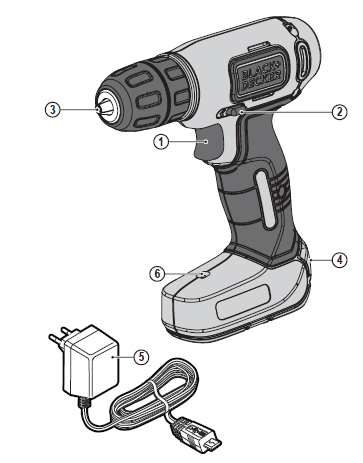
Assembly
Use
Warning! Let the tool work at its own pace. Do not overload.
Charging the battery
- The battery needs to be charged before first use and whenever it fails to produce sufficient power on jobs that were easily done before.
- The battery may become warm while charging; this is normal and does not indicate a problem.
- Do not charge the battery at ambient temperatures below 10 °C or above 40 °C.
- Recommended charging temperature: approx. 24 °C.
- The charger will not charge a battery if the cell temperature is below approximately 10 °C or above 40 °C.
- The battery should be left in the charger and the charger will begin to charge automatically when the cell temperature warms up or cools down.
- Plug the charger into any standard 230 Volts 50 Hz electrical outlet.
- Because this tool is equipped with a USB port, it can be charged through USB ports.
Ensure the cable (Micro USB) and port are USB compliant.
- Insert the charger plug (5) into the USB charging port (4)
- The charging indicator (6) will be lit, indicating that the battery inside the drill is being charged.
- When charging is completed the light (6) will turn off. u Let the tool charge initially for 9 hours.
- After the initial charge, under normal usage, your tool should be fully charged in 8 to 9 hours.
- Do not use tool while it is connected to the charger.
- When disconnecting the charger from the tool, be sure to unplug the charger from the outlet first, then disconnect the charger cord from the tool.
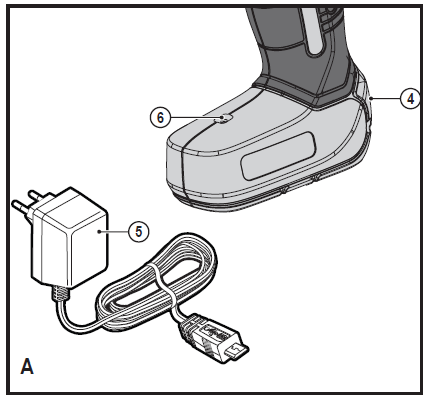
Trigger switch & reversing button
- The drill is turned ON and OFF by pulling and releasing the trigger switch
- A forward/reverse control button
- determines the direction of the tool and also serves as a lock off button.
- To select forward rotation, release the trigger switch and depress the forward/reverse control button to the left.
- To select reverse, depress the forward/ reverse control button the opposite direction.
- To lock the tool, set the forward/reverse slider into the centre position.
Note! The center position of the control button locks the tool in the off position. When changing the position of the control button, be sure the trigger is released.

Keyless chuck
Make certain the lock-off button is engaged to prevent switch actuation before installing or removing accessories.
To insert a drill bit or other accessory:
- Grasp the rear half of the chuck (7) with one hand and use your other hand to rotate the front half (8) in the counterclockwise direction, as viewed from the chuck end.
- Insert the bit or other accessory fully into the chuck, and tighten securely by holding the rear half of the chuck and rotating the front portion in the clockwise direction as viewed from the chuck end.
Warning! Do not attempt to tighten drill bits (or any other accessory) by gripping the front part of the chuck and turning the tool on. Damage to the chuck and personal injury may occur when changing accessories.
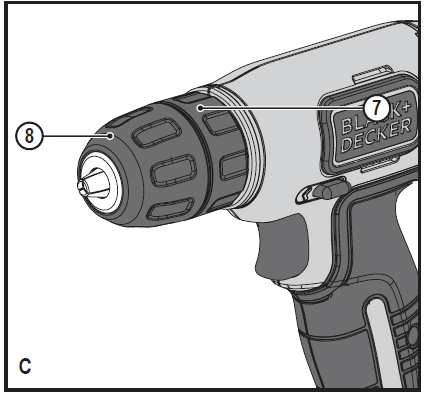
Drilling/screwdriving
- Select forward or reverse rotation using the forward/ reverse slider (2).
- To switch the tool on, press the switch (1). The tool speed depends on how far you press the switch.
- To switch the tool off, release the switch.
Hints for optimum use
Drilling
- Always apply a light pressure in a straight line with the drill bit.
- Just before the drill tip breaks through the other side of the workpiece, decrease pressure on the tool.
- Use a block of wood to back up workpieces that may splinter.
- Use spade bits when drilling large diameter holes in wood.
- Use HSS drill bits when drilling in metal.
- Use masonry bits when drilling in soft masonry.
- Use a lubricant when drilling metals other than cast iron and brass.
- Make an indentation using a centre punch at the centre of the hole to be drilled in order to improve accuracy.
Screw driving
- Always use the correct type and size of screwdriver bit.
- If screws are difficult to tighten, try applying a small amount of washing liquid or soap as a lubricant.
- Always hold the tool and screwdriver bit in a straight line with the screw
Troubleshooting
|
Problem |
Possible cause |
Possible solution |
|
Unit will not start. |
Battery pack not charged. |
Check battery pack charg- ing requirements |
|
Battery pack will not charge. |
Charger not plugged in.
Surrounding air temperature too hot or too cold. |
Plug charger into a work- ing outlet.
Move charger and battery pack to a surrounding air temperature of above 40 degrees F (45ºC) or below 105 degrees F (+40.5ºC) |
|
Unit shuts off abruptly. |
Battery pack has reached its maximum thermal limit.
Out of charge. (To maximize the life of the battery pack it is designed to shutoff abruptly when the charge is depleted |
Allow battery pack to cool down.
Place on charger and allow to charge. |
Maintenance
Your BLACK+DECKER tool has been designed to operate over a long period of time with a minimum of maintenance. Continuous satisfactory operation depends upon proper tool care and regular cleaning. Your charger does not require any maintenance apart from regular cleaning. Warning! Before performing any maintenance on the tool, remove the battery from the tool. Unplug the charger before cleaning it.
- Regularly clean the ventilation slots in your tool and charger using a soft brush or dry cloth.
- Regularly clean the motor housing using a damp cloth.
- Do not use any abrasive or solvent-based cleaner. u Regularly open the chuck and tap it to remove any dust from the interior.
- Protecting the environment Separate collection.
- Products and batteries marked with this symbol must not be disposed of with normal household waste.
- Products and batteries contain materials that can be recovered or recycled, reducing demand for raw materials.
- Please recycle electrical products and batteries according to local provisions. Further information is available at www.2helpU.com
Technical data
|
BDCD8 |
||
|
Voltage |
VDC |
7.2 |
|
No-load speed |
Min–1 |
400 |
|
Max. torque |
Nm |
8/12 |
|
Chuck capacity |
mm |
1-10 |
|
Max Drilling capacity |
|
|
|
Steel/wood |
mm |
NA/20mm |
|
Weight |
kg |
0.62 |
|
Charger |
|
QW:90623494, GB: 90623492 |
|
Input voltage |
VAC |
230 |
|
Output voltage |
VDC |
5 |
|
Current |
mA |
600 |
|
Approx. charge time |
Hours |
8 |
|
Battery |
||
|
Voltage |
VDC |
7.2 |
|
Capacity |
Ah |
1.5 |
|
Type |
|
Li-Ion |
|
Level of sound pressure according to EN 62841: |
|
Sound pressure (LpA) 60.7 dB(A), uncertainty (K) 5 dB(A) |
|
Sound power (LWA) 71.7 dB(A), uncertainty (K) 5 dB(A) |
|
Vibration total values (triax vector sum) according to EN 62841: |
|
Drilling into metal (ah, D)0.837 m/s2, uncertainty (K) 1.5 m/s2 |
Declaration of conformity
- Black & Decker declares that these products described under “technical data” are in compliance with: The Supply of Machinery (Safety) Regulations, 2008, S.I. 2008/1597 (as amended), EN62841-1:2015, EN62841-2-1:2018+A11:2019.
- These products conform to the following UK Regulations: Electromagnetic Compatibility Regulations, 2016, S.I.2016/1091 (as amended).
- The Restriction of the Use of Certain Hazardous Substances in Electrical and Electronic Equipment Regulations 2012, S.I. 2012/3032 (as amended).
- For more information, please contact Black & Decker at the following address or refer to the back of the manual.
- The undersigned is responsible for compilation of the technical file and makes this declaration on behalf of Black & Decker.
Guarantee
- Black & Decker is confident of the quality of its products and offers consumers a 24 month guarantee from the date of purchase.
- This guarantee is in addition to and in no way prejudices your statutory rights.
- The guarantee is valid within the territories of the Member States of the European Union and the European Free Trade Area and the United Kingdom.
- To claim on the guarantee, the claim must be in accordance with Black&Decker Terms and Conditions and you will need to submit proof of purchase to the seller or an authorised repair agent.
- Terms and conditions of the Black&Decker 2 year guarantee and the location of your nearest authorised repair agent can be obtained on the Internet at www.2helpU.com, or by contacting your local Black & Decker office at the address indicated in this manual. Please visit our website www.blackanddecker.co.uk to register your new Black & Decker product and receive updates on new products and special offers.
Black & Decker BDCD8 Small Angle Grinder Instruction Manual
FAQs
What is the BDCD8 angle grinder’s power rating?
Its 820-watt motor offers sufficient power for operations like cutting and grinding.
Is there a safety guard on the BDCD8?
Indeed, it has a safety guard that can be adjusted to shield the user from flying debris.
Which disc size is used by the BDCD8?
It makes use of commonly accessible 115mm (4.5-inch) discs.
Is there a spindle lock on the BDCD8?
Indeed, it has a spindle lock for secure and simple disc replacements.
Does the BDCD8 have the ability to cut metal?
Yes, it can cut through stone, brick, and metal if the right cutting disc is used.


